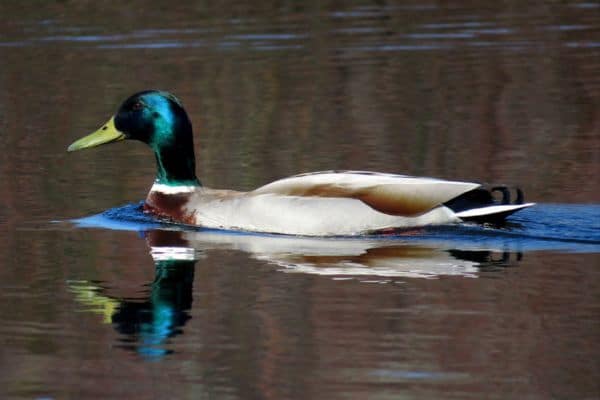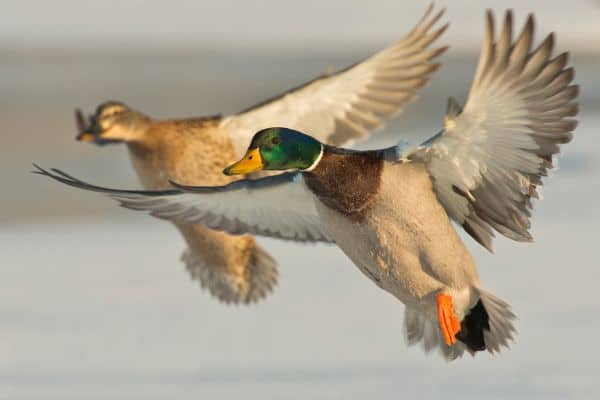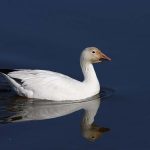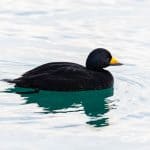Common Name: Mallard Duck
Scientific Name: Anas platyrhynchos| Size | Diet | Range in Hawaii | Status in Hawaii |
|---|---|---|---|
| 20 in. - 26 in. | aquatic plants, seeds, insects, crustaceans, and small fish | Common on all Islands | Least Concern |
The Mallard (Anas platyrhynchos) is one of the most well-known and widespread duck species in the world. This adaptable and hardy species is found in a variety of wetland and aquatic habitats across North America, Europe, and Asia, and is known for its distinctive green head, white collar, and iridescent blue wing patches.
The Mallard is also a popular subject for birdwatchers and nature enthusiasts, who appreciate its beauty and unique behaviors, such as its courtship displays and synchronized swimming.
In this article, we will explore the fascinating world of the Mallard, including its history, behavior, and current conservation status. We will also examine the species’ existence in Hawaii, where it is considered a non-native species that has been introduced for recreational hunting purposes.
Despite its non-native status, the Mallard has established populations in Hawaii and is a common sight in wetlands and coastal habitats on the islands. Join us as we delve into the world of the Mallard, one of the most fascinating and beloved duck species in the world.
Mallard
Appearance

The Mallard duck is a medium-sized species of duck that is found throughout much of the world. The species has a distinctive appearance, with a green head, white collar, and iridescent blue wing patches.
The male Mallard is larger and more colorful than the female, with a bright green head, yellow bill, and reddish-brown breast. The female Mallard has a mottled brown appearance with a dark bill and orange legs. The Mallard is a medium-sized duck, measuring about 20-26 inches (51-66 cm) in length and weighing between 1.5-3.5 pounds (0.7-1.6 kg).
Diet
The Mallard duck is an omnivorous species that feeds on a variety of plant and animal matter. The species’ diet includes aquatic plants, seeds, insects, crustaceans, and small fish.
The Mallard is a dabbling duck, meaning that it feeds by tipping its head down and grazing on the surface of the water or on land. The species is also known to forage in wetland habitats such as ponds, marshes, and coastal areas, where it feeds on a variety of food sources.
Nesting
The Mallard duck is a ground-nesting species that typically forms pair bonds during the breeding season. The species’ nesting behavior is influenced by its habitat, which includes wetland and aquatic habitats such as ponds, lakes, and rivers.
The female Mallard constructs a shallow depression lined with grasses and other vegetation on the ground, where she lays a clutch of 8-13 eggs. The eggs are incubated by the female for about 26-30 days, and the parents take turns caring for the young.
The young are able to leave the nest and feed on their own within a few hours of hatching. The nesting success of the Mallard can be influenced by a variety of factors, including habitat quality, predation, and human disturbance.
Behavior

The Mallard duck is a fascinating and adaptable species that exhibits a variety of behaviors that are adapted to its wetland and aquatic habitats. The species is typically monogamous, forming pair bonds during the breeding season.
The Mallard is also known for its distinctive vocalizations, which include a range of quacks and grunts. The species is an omnivore, feeding on a variety of plant and animal matter, and is often observed foraging in wetland habitats such as ponds and marshes.
The Mallard is a dabbling duck, meaning that it feeds by tipping its head down and grazing on the surface of the water or on land. The species is also known for its courtship displays, which can include synchronized swimming and head-bobbing.
Habitat
The Mallard duck is a highly adaptable species that is found in a variety of wetland and aquatic habitats across much of the world. The species’ habitat includes ponds, lakes, rivers, marshes, and coastal areas, where it feeds on a variety of plant and animal matter.
The Mallard is a dabbling duck, meaning that it feeds by tipping its head down and grazing on the surface of the water or on land. The species is also known to forage in wetland habitats such as ponds, marshes, and coastal areas, where it feeds on a variety of food sources.
Range
The Mallard duck has been introduced to Hawaii for recreational hunting purposes and has established populations on the islands. The species is considered a non-native species in Hawaii and is not protected under the federal Migratory Bird Treaty Act.
The Mallard is a common sight in wetland and coastal habitats on the islands, and is known to hybridize with other duck species that have also been introduced to Hawaii, such as the Hawaiian duck (Anas wyvilliana). The presence of non-native duck species in Hawaii has raised concerns about their potential impact on native bird species and ecosystems.
Conservation Status
The Mallard duck is a species of least concern according to the International Union for Conservation of Nature (IUCN). The species has a wide range and large populations, and is not considered to be facing significant threats to its survival.
However, habitat loss and degradation, hunting, and competition with non-native duck species can impact local populations of Mallards. In some areas, Mallards are considered an invasive species and efforts are underway to control their populations.
The species is also protected under the Migratory Bird Treaty Act in the United States, which regulates hunting and other activities that may impact the species.
Interesting Facts
1. Recognizable duck species in the world
Mallards are one of the most widespread and recognizable duck species in the world. They can be found across Europe, Asia, North America, and parts of Africa.
2. They have specialized bill
Mallards have a specialized bill that contains fine lamellae (comb-like structures) along the edges, which filter out water and help them retain food.
3. They are monogamous
Mallard ducks are monogamous during the breeding season, and pairs typically form for a single breeding season but do not necessarily mate for life.
4. Exhibit a strong sense of direction
These ducks exhibit a strong sense of direction and can navigate using landmarks, the position of the sun, and Earth’s magnetic field.
5. Known to hybridize with other duck species
Mallards are known to hybridize with other duck species, leading to various combinations and unique plumage patterns.
Frequently Asked Questions
1. Do Mallard ducks migrate?
Mallards are generally migratory, but some populations are resident or partially migratory, depending on the availability of suitable food and water sources.
2. How do Mallard ducks differ from other duck species?
Mallard drakes have a distinctive plumage with a glossy green head, a yellow bill, a white collar around the neck, a chestnut-colored breast, and grayish-brown body feathers. Female Mallards have a mottled brown plumage for camouflage.
3. How long do Mallard ducks live?
Mallard ducks typically have a lifespan of 5 to 10 years in the wild. However, with favorable conditions, good nutrition, and protection from predators, some individuals have been known to live up to 20 years or more. Factors such as habitat quality, food availability, and predation can affect their longevity.
4. Are Mallard ducks a social species?
Mallard ducks are social animals and often form flocks, especially during the non-breeding season. These flocks can range in size from a few individuals to several hundred ducks.




